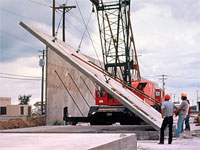Tilt-up concrete construction is one of the fastest-growing building technologies in North America, with at least 10,000 structures—enclosing more than 650 million square feet of space—being built every year. While tilt-up has been in existence for more than a century, the 1940s saw a surge of interest in the method, and today tilt-up builds more than 15 percent of industrial buildings in the United States, according to the
Tilt-Up Concrete Association.
Building Process

When building with tilt-up, the site is prepared, walls are cast on-site on the floor slab, and then tilted up and secured in place. Engineering plays a key role in the creation of tilt-up buildings: wall panels must be able to withstand lifting loads, and floor slabs must be able to withstand crane and/or bracing loads during construction. Recent evolutions in component and mix design mean that structures can incorporate thinner, taller panels than ever before. And tilt-up panels can be finished in myriad ways, offering aesthetic flexibility.
One of the most evident benefits of tilt-up concrete construction is speed. Wall panels are often placed while the rest of the building systems are designed, and trades can begin work quickly, speeding time to occupancy. Tilt-up structures also offer all the energy efficiency, strength, and durability long associated with concrete.
Sustainability
Tilt-up is widely recognized as an environmentally friendly construction method. Because walls are cast on-site, transportation costs are minimized. Typically, the thermal mass of tilt-up eliminates the need for insulation. Of the approximately 25 percent of panels that are insulated, most use non-conductive ties to take best advantage of thermal mass properties—creating a solid, insulated energy-efficient wall. The large panels (the record is just over 92 feet tall) require less energy and labor for erection and finishing. And tilt-up buildings can be designed to accommodate change, with panels that are easy to move, remove and reuse, or even recycle if necessary.
Industry Resources
ACI 551R includes recommendations for many aspects of tilt-up construction, including design, engineering, placement, maintenance, and more.
The Tilt-Up Concrete Association offers a variety of resources for engineers, architects, and contractors. Get the essential methods and skills of tilt-up construction and the “Top Ten” tilt-up record-holders.
Publication
 PCA Notes on ACI 318-05 Building Code Requirements for Structural Concrete with Design Applications, EB705
PCA Notes on ACI 318-05 Building Code Requirements for Structural Concrete with Design Applications, EB705
The ninth edition of this classic PCA resource reflects code changes introduced in Building Code Requirements for Structural Concrete, ACI 318-05. These notes will help users apply code provisions related to the design and construction of concrete structures.